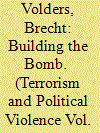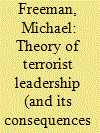| Srl | Item |
| 1 |
ID:
112469


|
|
|
|
|
| Publication |
2012.
|
| Summary/Abstract |
Although the issue of knowledge diffusion has been at the heart of nonproliferation research and policies, no study in the political science field has thus far systematically identified the mechanisms that allow the acquisition and efficient use of specialized knowledge related to bioweapons. This analytical gap has led to the commonly held belief that bioweapons knowledge is easily transferable. Studies of past weapons programs, including the former U.S. and Soviet bioweapons programs, show that gathering the relevant information and expertise required to produce a weapon is not sufficient to guarantee success. The success of a bioweapons program is dependent on intangible factors, such as work organization, program management, structural organization, and social environment, which can enhance the advancement of a program or create obstacles to progress. When assessed within smaller state and terrorist bioweapons programs, such as those of South Africa and the terrorist group Aum Shinrikyo, these intangible factors produce the same constraining effects as in larger programs. More important, intangible factors have a significant effect on covert programs, because clandestinity imposes greater restrictions on knowledge diffusion. By taking into account these intangible factors, analysts and policymakers can improve their threat assessments and develop more effective nonproliferation and counterproliferation policies.
|
|
|
|
|
|
|
|
|
|
|
|
|
|
|
|
| 2 |
ID:
183002


|
|
|
|
|
| Summary/Abstract |
A terrorist organization constructing and detonating a nuclear device is often a topic of popular, academic, and political concern. Yet, assessing this risk is a challenging task. This article aims to contribute to the encompassing nature of any future nuclear terrorism threat assessments by further exploring the often overlooked organizational dimension in probability assessments on nuclear terrorism. Particular emphasis is given to the role of the organizational design. In order to do so, this article theoretically builds on a 2017 research article and empirically studies Aum Shinrikyo’s chemical and biological armament activities. This article confirms and further refines the idea of an effectiveness-efficiency trade-off for a terrorist organization implementing a nuclear armament project. It particularly zooms in on the constraints that follow from the covert nature of this type of plot and elaborates on the role of Aum Shinrikyo’s value-rationality.
|
|
|
|
|
|
|
|
|
|
|
|
|
|
|
|
| 3 |
ID:
133543


|
|
|
|
|
| Publication |
2014.
|
| Summary/Abstract |
States often target terrorist leaders with the belief that the leader's death or capture will cause the terrorist organization to collapse. Yet the history of this strategy of "leadership targeting" provides a mixed record-for every example of effectiveness, there are similar examples of ineffectiveness. The central question of this article is: what makes a terrorist leader important? Specifically, what does a terrorist leader do that no one else can do (or do as well) for the organization? To answer this question, I develop a theory of terrorist leadership that argues that leaders might potentially perform two main functions: they can provide inspiration and/or operational direction (or not for both). I also theorize as to how and why the provision of these functions changes over time as the organization itself changes. The consequences for leadership targeting flow naturally from this theory-when leaders provide these functions to the organization, leadership targeting is most likely to be effective. Case studies of Algeria, Peru, and Japan offer insights into why some cases of leadership targeting were effective and why others were not. The conclusion extends this model with an analysis of al-Qaeda's prospects after the death of bin Laden.
|
|
|
|
|
|
|
|
|
|
|
|
|
|
|
|